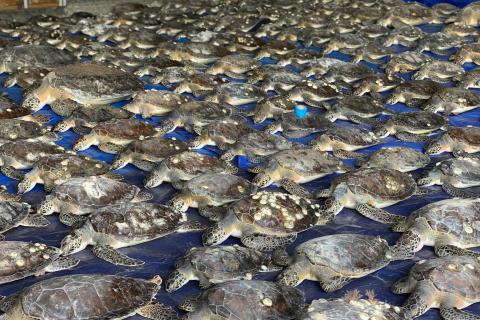In February 2021, Texas experienced a historic cold snap that created many hardships for people and wildlife alike. As a result, February 14, 2021 marked the beginning of the largest sea turtle cold stunning event in the U.S. since record keeping began.
Researchers at Texas A&M Corpus Christi found that during this historic event water temperatures along the Gulf coast fell to a low of 34 degrees Fahrenheit and an air temperature low in the area of 20 degrees. At water temperatures below 50 degrees, sea turtles become cold-stunned, that is, their heart rates and circulation slow and they become lethargic. They stop swimming and float to the water’s surface. Thanks to the heroic efforts of hundreds of rescuers, thousands of stranded sea turtles were gathered and taken to protective facilities where they could slowly regain warmer body temperature.
While multiple funding streams support the backbone of this work, the Trustee’s Sea Turtle Early Restoration Project helped with the collection of more than 13,000 sea turtles. Despite days of extreme cold and high winds, more than 4,000 turtles were successfully released back into the Gulf of Mexico.
The Sea Turtle Early Restoration Project helped to fund the work of many of the rescuers. It was one of the first projects approved for the Texas restoration area. The $45 million project has four components; one of which directly provides funds to support rescues, salvage, rehabilitation, and associated activities. This component distributes funds through three Trustees: the Department of the Interior, NOAA, and Texas to a number of agencies and organizations that contribute to rescue efforts along the Gulf coast, including:

from a mission to rescue cold stunned sea turtles.
- Padre Island National Seashore
- Texas Parks and Wildlife
- NOAA Fisheries
- Sea Turtle, Inc.
- Texas A&M Galveston
- Amos Rehabilitation Keep
These entities, plus many other organizations and volunteers, worked hard to save the cold stunned sea turtles.
“It was truly amazing to see the tireless effort and cooperation among those that came together to help sea turtles affected by this event,” commented Dr. Brian Stacy, NOAA veterinarian that assisted with the emergency response.
“Worldwide, stranding networks lack the funding needed to meet demand,” said Dr. Donna Shaver, Chief of the Division of Sea Turtle Science and Recovery at the National Park Service. “The funding from the Early Restoration project was truly needed to accomplish all we did with this year’s historic event. It’s been a blessing for the Texas sea turtle stranding network.”
Dr. Shaver also noted that while the green sea turtle population was impacted by the high mortality from this event, years of successful conservation efforts and the tremendous response to this event, likely prevented a catastrophe for this species in Texas waters.


